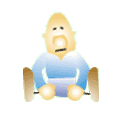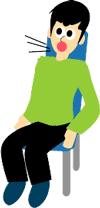Relaxation Techniques - Meditation
 Origin:
Origin:
Meditation is grounded in eastern culture, especially in India and Tibet. It became popular in western culture in the recent years. Maharishi Mahesh Yogi introduced meditation into western culture with the purpose of helping the stressed people effectively.
Meditation teaches us to focus on a word or an image, be quiet and cut off all the distracted thinking. The process of meditation is as follows:
- Choose a place and time that we could cut off all the disturbances, switch off the mobile phones and pagers.
- Sit down on a straight-backed chair, put our hands on our legs. Keep the upper parts of our body straight, and don't let our head and shoulders collapse. Hold this straight position and relax our muscles at the same time.
- Close our eyes. Put all of our attention on our breathing, and keep all the things natural
- Don't shift
our attention from breathing to the other part of our body. Choose a
focal point, e.g., focus on our nose or stomach, let the feeling of
breathing occupy all our senses.

- When distracted thinking appear, don't follow it or push it out. Focus on our breathing only, count one when inhaling air and count two when exhaling air, focus on our breathing.
- After meditation, stand up slowly. Keep the balanced sensation we have experienced in meditation while we are performing other activities.
- It is better to practise meditation at the same time every day. Five minutes is enough for a beginner, after a period of time, the time can be prolonged to 15 to 20 minutes or more.
Benefits of Meditation:
| (1) Physiological aspects: | It can slow down heart rate and breathing rate, reduce muscle tension, oxygen exhaustion, and brain waves emission, etc |
| (2) Psychological aspects: | It can strengthen the sense of self-control, develop a positive attitude towards stress, help us to sleep easily, recover from migrate headaches, reduce tension, anxiety, fear, smoking and drug abuse. |
Dos
and Don'ts:
- It is better to practise meditation immediately upon waking up and right before dinner. Do not mediate after a meal because the blood would pool in the stomach to perform the digestive process. Therefore, it reduces the blood flowing to the arms and legs. And hence it is against of the idea of relaxation, i.e. to increase the blood flowing to the arms and legs and relax the whole body.
- Reduce the intake of stimulant, e.g. coffee, tea, coca cola, cigarette, etc., because they would stimulate our body and make us difficult to relax.
- When practising meditation, it is better to sit on a straight-backed seat. Avoid lying down and hence getting sleepy.
- Meditation is to focus on our breathing. If we cannot achieve it and often shift our attention to other thoughts, we can count one when inhaling air and count two when exhaling air. This can assist us to put our attention back on breathing.
- If we cannot put all our daily hassles aside, we must forget all of them during meditation. Avoid breathing too fast, or opening our eyes too often to check the time. Try to slow down, relax ourselves and enjoy the whole process.
- If we want to do a twenty-minutes meditation, do not set the alarm clock to go off after twenty minutes. We can slightly open your eyes and check the time. If it is twenty minutes, stop immediately; if not, we can continue. When we become more familiar with meditation, we will know when twenty minutes have gone by.
- The sound of alarm clock, mobile phone and pager will affect our meditation status. We have to switch them off.